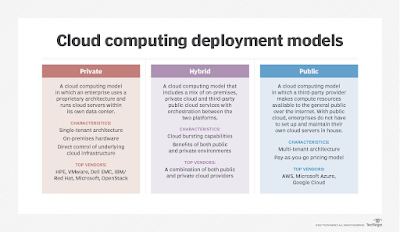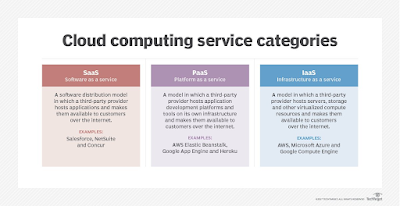According to IBM website?
Cloud use cases
With 25% of organizations planning to
move all their applications to cloud within the next year, it would
seem that cloud computing use cases are limitless. But even for
companies not planning a wholesale shift to the cloud, certain initiatives
and cloud computing are a match made in IT heaven.
Disaster
recovery and business continuity have always been a natural
for cloud because cloud provides cost-effective redundancy to protect data
against system failures and the physical distance required to recover data and
applications in the event of a local outage or disaster. All of the major public cloud providers offer Disaster-Recovery-as-a-Service
(DRaaS).
Anything that involves storing and processing huge volumes
of data at high speeds—and requires more storage and computing capacity than
most organizations can or want to purchase and deploy on-premises—is a
target for cloud computing. Examples include:
·
Big data analytics
·
Internet of Things (IoT)
·
Artificial
intelligence—particularly machine learning and deep learning applications
For development teams adopting Agile or DevOps (or DevSecOps) to streamline development, cloud offers the on-demand end-user self-service that keeps operations tasks—such as spinning up development and test servers—from becoming development bottlenecks.
From <https://www.ibm.com/in-en/cloud/learn/cloud-computing#toc-what-isclo-mt3Y0Fsu>
IBM Cloud offers the most open and secure public cloud platform for business, a next-generation hybrid multicloud platform, advanced data and AI capabilities, and deep enterprise expertise across 20 industries. IBM Cloud hybrid cloud solutions deliver flexibility and portability for both applications and data. Linux®, Kubernetes, and containers support this hybrid cloud stack, and combine with RedHat® OpenShift® to create a common platform connecting on-premises and cloud resources.
From <https://www.ibm.com/in-en/cloud/learn/cloud-computing#toc-what-isclo-mt3Y0Fsu>
According to Microsoft website?
What is Azure?
The Azure cloud platform is more than 200 products and cloud services designed to help you bring new solutions to life—to solve today’s challenges and create the future. Build, run and manage applications across multiple clouds, on-premises and at the edge, with the tools and frameworks of your choice.
From <https://azure.microsoft.com/en-in/resources/cloud-computing-dictionary/what-is-azure/>
According to Investopedia website?
The World of Business
Businesses can employ cloud computing in different ways.
Some users maintain all apps and data on the cloud, while others use a hybrid
model, keeping certain apps and data on private servers and others on the
cloud.
When it comes to providing services, the big players in the
corporate computing sphere include:
·
Google Cloud
·
Amazon
Web Services (AWS)
·
Microsoft Azure
·
IBM Cloud
·
Alibaba Cloud
Amazon Web Services is 100% public and includes a
pay-as-you-go, outsourced model.8 Once you’re on the platform you can sign
up for apps and additional services. Microsoft Azure allows clients to keep
some data at their own sites. Meanwhile, Alibaba Cloud is a subsidiary of the
Alibaba Group.
From <https://www.investopedia.com/terms/c/cloud-computing.asp#toc-what-is-cloud-computing>
What Is an Example of Cloud Computing?
Today, there are several examples of cloud computing applications used by both businesses and individuals. One type of cloud service would be streaming platforms for audio or video, where the actual media files are stored remotely. Another would be data storage platforms like Google Drive, Dropbox, OneDrive, or Box.
From <https://www.investopedia.com/terms/c/cloud-computing.asp#toc-what-is-cloud-computing>
According to techtarget website?
Cloud computing examples and use cases
Cloud computing has evolved and diversified into a wide
array of offerings and capabilities designed to suit almost any conceivable
business need. Examples of cloud computing capabilities and diversity include
the following:
·
Google Docs, Microsoft 365. Users can
access Google Docs and Microsoft 365 through the internet. Users can be more
productive because they can access work presentations and spreadsheets stored
in the cloud at anytime from anywhere on any device.
·
Email, Calendar, Skype, WhatsApp. Emails,
calendars, Skype and WhatsApp take advantage of the cloud's ability to provide
users with access to data remotely so they can access their personal data on
any device, whenever and wherever they want.
·
Zoom. Zoom is a cloud-based software
platform for video and audio conferencing that records meetings and saves them
to the cloud, enabling users to access them anywhere and at any time. Another
common communication and collaboration platform is Microsoft Teams.
·
AWS
Lambda. Lambda enables developers to run code for applications or
back-end services without having to provision or manage servers. The
pay-as-you-go model constantly scales with an organization to accommodate
real-time changes in data usage and data storage. Other major cloud providers
also support serverless
computing capabilities, such as Google Cloud Functions and Azure
Functions.
From <https://www.techtarget.com/searchcloudcomputing/definition/cloud-computing>
Cloud computing vs. traditional web hosting
Given the many different services and capabilities of the
public cloud, there has been some confusion between cloud computing and major
uses, such as web hosting. While the public cloud is often used for web
hosting, the two are quite different. A cloud service has three distinct
characteristics that differentiate it from traditional web hosting:
1.
Users can access large amounts of computing
power on demand. It is typically sold by the minute or the hour.
2.
It is elastic -- users can have as much or as
little of a service as they want at any given time.
3.
The service is fully managed by the provider --
the consumer needs nothing but a personal computer and internet access.
Significant innovations in virtualization and distributed
computing, as well as improved access to high-speed internet, have
accelerated interest in cloud computing.
From <https://www.techtarget.com/searchcloudcomputing/definition/cloud-computing>
Cloud computing service providers
The cloud service market has no shortage of providers. The
three largest public CSPs that have established themselves as dominant fixtures
in the industry are the following:
·
AWS
·
GCP
·
Microsoft Azure
Other major CSPs include the following:
·
Apple
·
Citrix
·
IBM
·
Salesforce
·
Alibaba
·
Oracle
·
VMware
·
SAP
·
Joyent
·
Rackspace
When considering a cloud service vendor, certain
considerations should be taken. First, the actual suite of services can vary
between providers, and business users must select a provider that offers
services -- such as big data analytics or artificial intelligence (AI)
services -- that support the intended use case.
Though cloud services typically rely on a pay-per-use model,
different providers often have variations in their pricing plans to consider.
Furthermore, if the cloud provider will be storing sensitive data, physical
location of the provider's servers should also be considered.
Naturally, reliability and security should be top priorities. A provider's service-level agreement should specify a level of service uptime that is satisfactory to client business needs. When considering different cloud vendors, close attention should be given to what technologies and configuration settings are used to secure sensitive information.
From <https://www.techtarget.com/searchcloudcomputing/definition/cloud-computing>
According to leewayhertz website?
What is a Cloud-based Healthcare System?
Cloud-based healthcare refers to integrating cloud computing
technology for the creation and management of cloud-based health care services.
More healthcare providers are looking to work with vendors that provide cloud
computing solutions to save and retrieve their digital records. As the
information can be stored securely off-site, it is regarded as a significant
benefit for large and small provider organizations. A Cloud-based healthcare
system addresses the following essential requirements in the healthcare
industry:
·
On-demand access to computing with enormous
storage resources, which are not feasible in traditional healthcare systems.
·
Support large datasets for EHR, radiology images
and genomic data offloading.
·
Ability to share EHR among authorized
physicians, hospitals and care-providing institutions in different geographic
locations, offering timely access to life-saving information and minimizing the
needs of duplicate testing.
·
Improvement in analysis and monitoring the data
on diagnosis, treatment, cost and performance.
A cloud-based healthcare system reduces operational spending
while giving better-personalized care, efficient workflows, resulting in better
health services. At the same time, patients receive quicker responses from
healthcare providers and can access their healthcare data with improved
tracking.
When a healthcare ecosystem is managed on an on-premise
server, it includes EMR and medical billing systems. Therefore, the expenses
will be high due to overhead factors such as
·
Maintenance of upgrading records
·
Backup amenities
·
Load balancing issues
·
Space Utilization
With these shortcomings, opting for a cloud health strategy
is a need of time. Adopting a cloud-based health system would manage all
overheads and infrastructure. The cloud-based healthcare system develops a
confined plan in remote patient monitoring with telehealth and telemedicine
solutions. Regulating easy interoperability with an organized hierarchy are the
objectives of any cloud-based healthcare system. A well-organized cloud-based
healthcare system develops new insights for healthcare management solutions. As
cloud computing is a giant shared pool in the healthcare industry, cloud
solutions can scale up or shrink all the storage resources and adapt to
ever-changing needs.
From <https://www.leewayhertz.com/cloud-computing-in-healthcare/>
According to infoworld website?
Cloud computing is reinventing cars and trucks
Cloud-defined, cloud-operated cars are the future of the
auto industry. Innovating to make cars better, safer, and more efficient will
be the next cloud battleground.
From <https://www.infoworld.com/article/3675373/cloud-computing-is-reinventing-cars-and-trucks.html>
As this article from The
Wall Street Journal points out (behind a paywall), automobiles
are becoming the focus of technology providers, including cloud providers. If
you’ve been paying attention, you’ve realized that cars are becoming
software-defined. Any Tesla owner can tell you about some new capability or
feature that was part of a software update.
From <https://www.infoworld.com/article/3675373/cloud-computing-is-reinventing-cars-and-trucks.html>
These many are the definitions and descriptions of Cloud Computing
at your perusal from reputed websites. Choose any one/two or many definitions
in your seminar topic article.
If you find any other related links, please add them in comment
section. That will help other students to find the material easily.
…till next post,
bye-bye & take-care.






